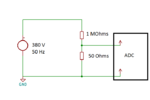julian403
Full Member level 5

ADC input: What are that resistance?
Hello All.
I need to sense 220 AC voltage signals with F28377S LaunchPad Development Kit. So for that, I'm going to use de differential 16 bit ADC but I have a question related with the input impedance. As you can see in the next picture.

My question is, The resistance Rs, are the Cooper path resistance from the board's input to ADC input?
Hello All.
I need to sense 220 AC voltage signals with F28377S LaunchPad Development Kit. So for that, I'm going to use de differential 16 bit ADC but I have a question related with the input impedance. As you can see in the next picture.

My question is, The resistance Rs, are the Cooper path resistance from the board's input to ADC input?




